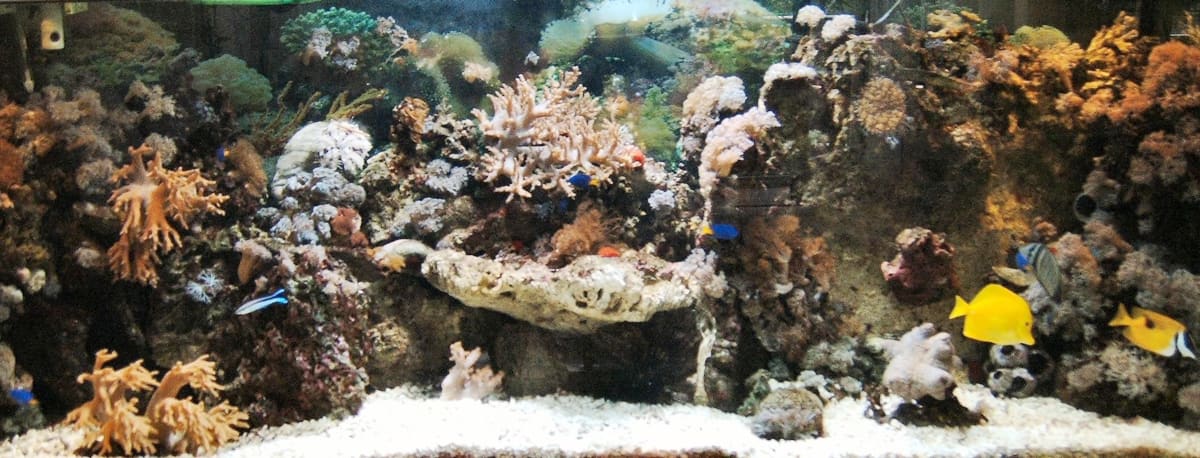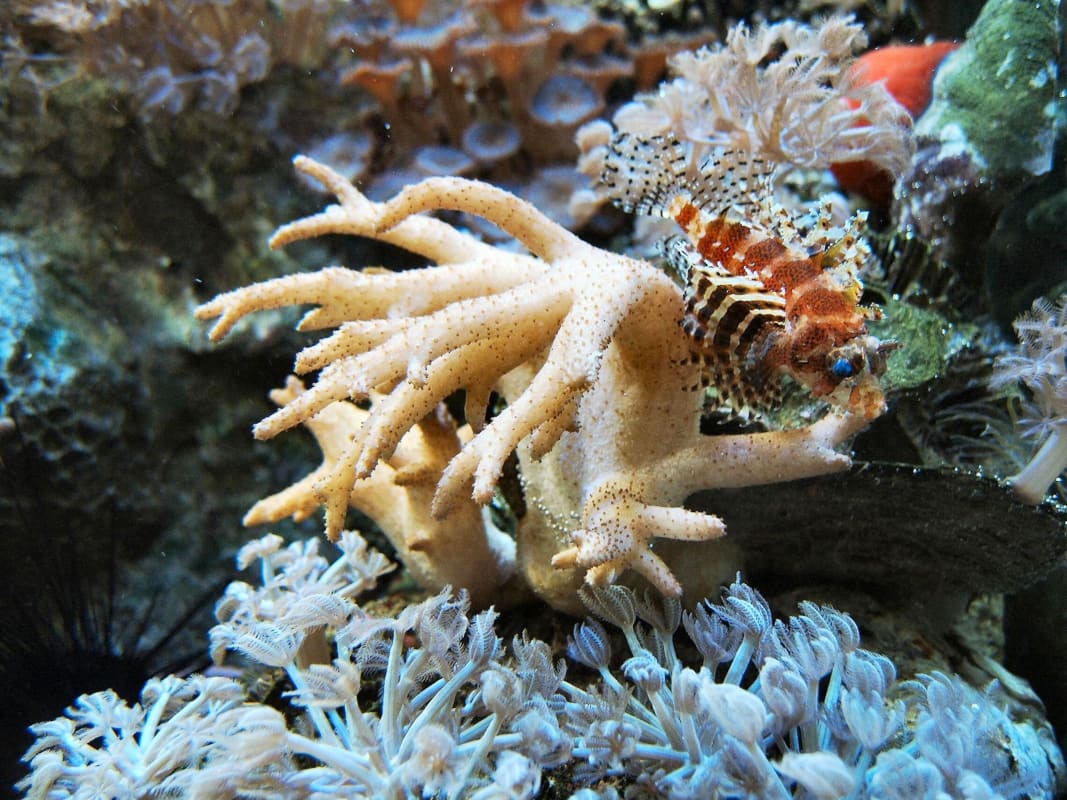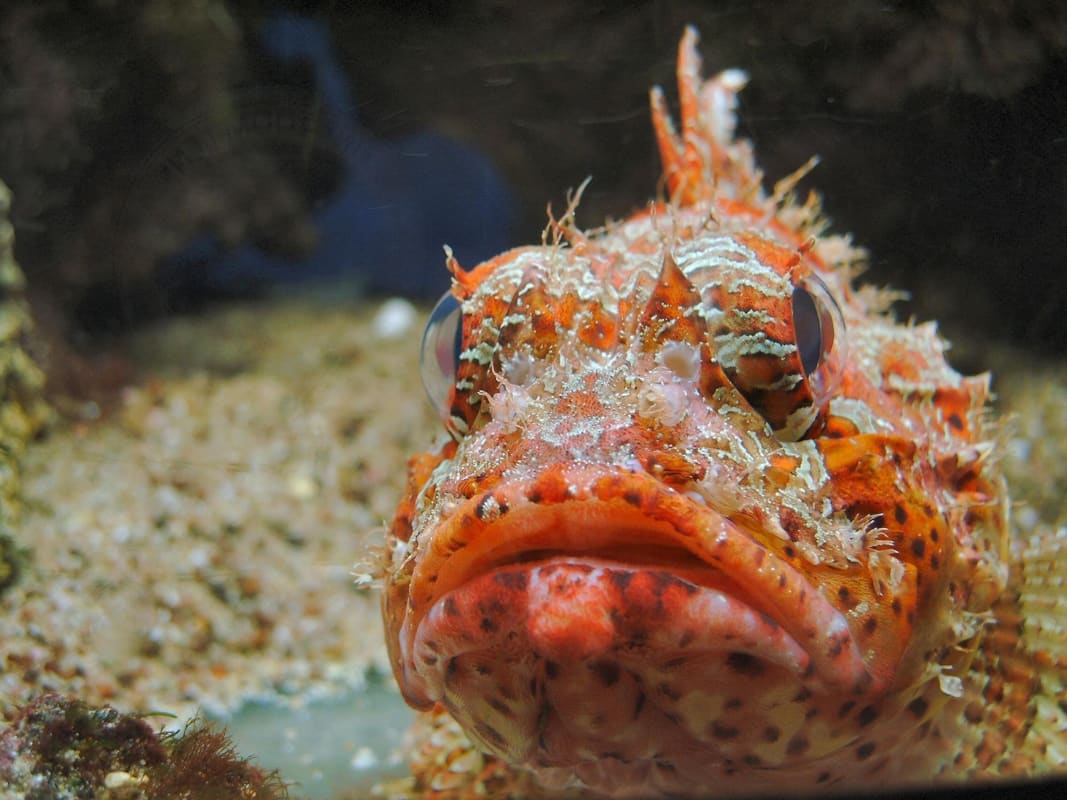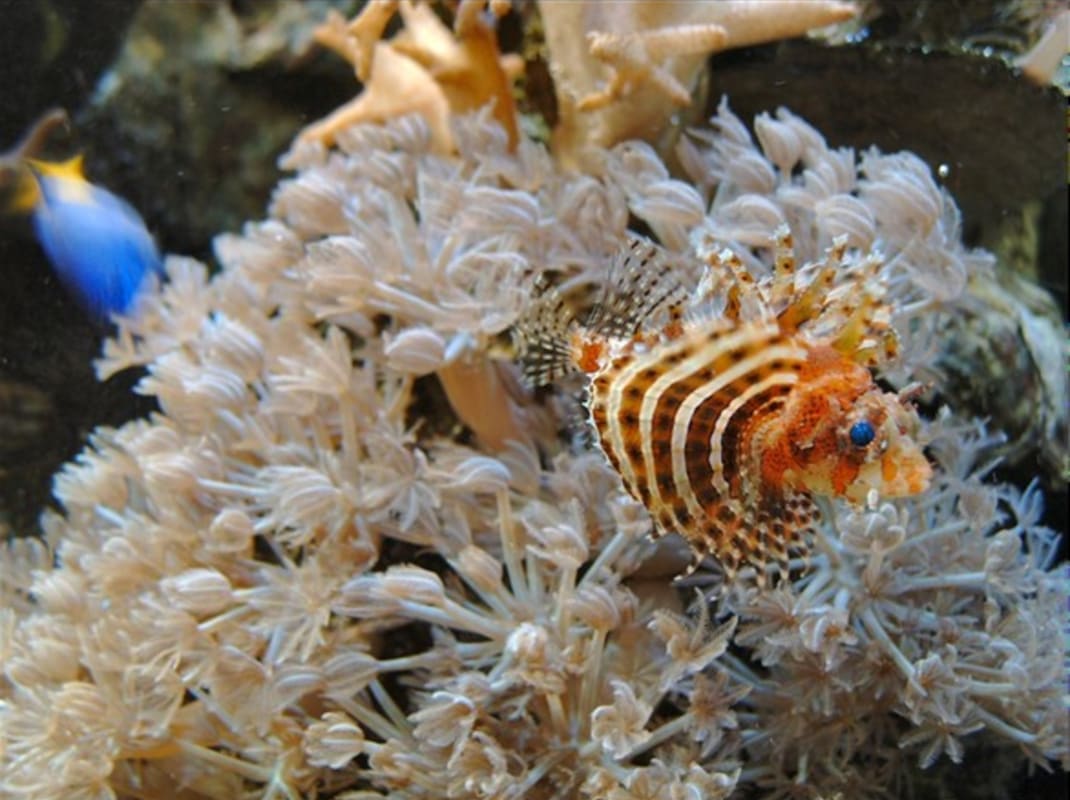The attractive lionfish belong to the order SCORPAENIFORMES, suborder Scorpaenoidei, family Scorpaenidae (scorpaenid fishes), subfamily Pteroinae. Successfully keeping them together with other fish in a reef aquarium presents a special challenge with various requirements and some risks.
This article is part of a series of articles on “Experiences with saltwater aquariums”. In this loose collection, our author Andreas Berns — an aquarium consultant with many years of experience with aquariums of all types and sizes — reports anecdotally and entertainingly on special aquarium inhabitants, interesting integration projects and curious experiences. He also gives valuable tips on keeping the species described.
The following stories have been published so far:
Beware of poison: Lionfish in the reef aquarium
Pretty clever: a pallet doctor moves house & gets socialized
Tridacnidae: A myth in the sea
Tough little gemstone in the marine aquarium: the horse actinia Actinia equina
Especially the hunting behavior of these carnivorous reef inhabitants poses a challenge for keeping them with other fish. Additionally, their space requirements should not be underestimated.
Below are my recommendations and tips for keeping firefish in a saltwater aquarium, based on experiences that both my father and I have had with these beautiful, yet venomous and somewhat challenging creatures.
The beginning
In the late 1970s, my father started his first attempts at keeping lionfish in combination with smaller fish.
In a pure fish tank, together with a paddlefish, some tangs, and a school of small reef fish, he managed to condition a Pterois volitans (red lionfish) in its hunting and feeding behavior to respond to a visual and acoustic signal, so that it would only eat the offered feeder fish. The feeder fish were initially always silver-colored, similarly sized baitfish from a fishing shop. All other tank mates remained undisturbed, and the experiment was successful for many years and was repeated multiple times. (See also DATZ Year 1979, page 132 ff., J. Berns).
The success of the aforementioned experiments was largely due to the meticulous and regular feeding schedule, with the consistent use of the same signal cues (always the same live baitfish, always the same knocking pattern as a feeding announcement). Attempts using dead substitute food ultimately failed, as in these cases, one or another reef fish or a shrimp would inevitably fall victim to the predatory instincts of the lionfish.
Feeding exclusively live baitfish and the resulting high metabolic turnover of the lionfish only allowed for their care in pure fish aquariums. The water load, combined with the limited mechanical and biological filtration options available for home aquariums at the time, would have meant a quick and certain death for almost all corals, whether hard or soft corals.
However, this limitation was easy to tolerate over 40 years ago, as the keeping of soft and hard corals was almost exclusively reserved for a few public aquariums due to the limited and nearly unaffordable availability, as well as the technical effort required.
The development
Today, marine aquarists have significantly more options available to them. On the one hand, affordable technology has become available to hobbyists, such as effective protein skimmers, sophisticated filtration systems, and excellent pre-mixed salt blends. Lighting technology has also made significant advancements. Additionally, the expertise among aquarists—often through a collaborative effort between “amateurs” and scientists—has continued to develop. As a result, the focus of marine aquariums has shifted. Purely “fish-only aquariums” have become increasingly rare (unfortunately, I must say, as some species are still best cared for in these setups). “Coral gardens,” where fish were only a secondary element, have become more prominent. In my view, this is a misguided development, because both fish and corals are inseparable and should ideally be maintained together.
Fortunately, in recent years, the establishment of reef aquariums, where corals and fish are maintained in a mutually supportive ecosystem, has come to the forefront. For an increasing number of aquarists, keeping such communities has become the central focus of their aquarium endeavors.
The socialization of lionfish in a reef aquarium.
At this point, the desire arises to keep lionfish in a reef aquarium, alongside other small fish as well as soft and stony corals. This is indeed possible, but it requires some fundamental considerations and good planning:
1. Lionfish grow large!
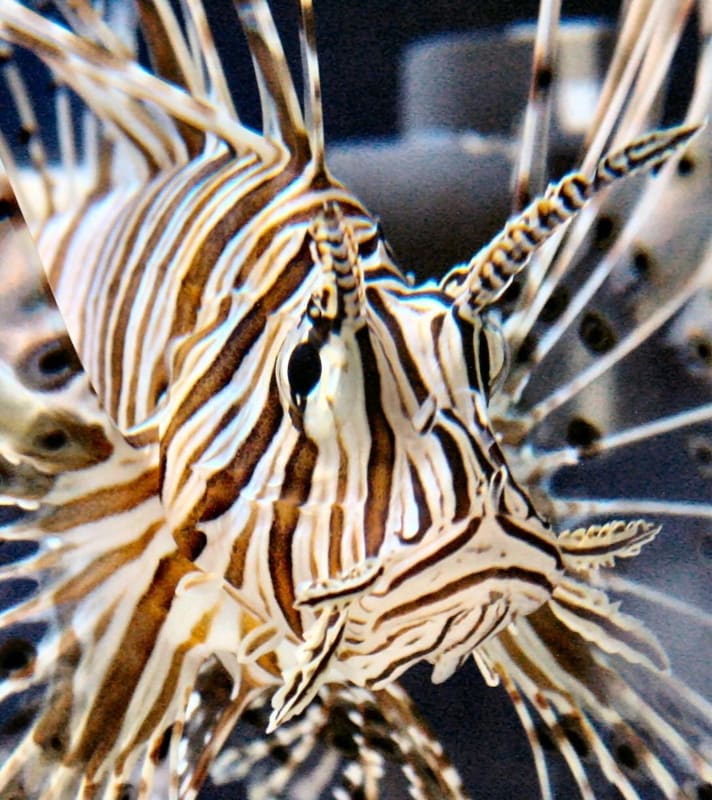
Unlike in the fish-only aquariums of earlier times, where “free swimming space” dominated and often made up over 80% of the total volume, modern reef aquariums often have much more cramped conditions: Natural-looking reef structures made from live rock and substitute materials, along with a variety of stony and soft corals, naturally require space and significantly limit swimming areas. Sand zones are typically kept to a minimum, and the reef structure often extends close to the front glass panels.
The Pterois volitans can easily reach a length of 25 cm or more in our home aquariums with proper feeding (which should be a given), and when its pectoral fins are spread out, it also reaches a similar width.
Although most lionfish are quite sluggish and generally slow swimmers, they still require ample swimming space for their well-being, as well as suitably large hiding spots and overhangs as resting and ambush zones. Therefore, reef aquariums for keeping lionfish must either be very large (for Pterois volitans, at least 1000 liters), or we must limit ourselves to selecting species that remain relatively small.
2. Lionfish are predators!
Conditioning lionfish to feed exclusively on baitfish is possible, but it would lead to constant high water pollution, which would negatively affect the well-maintained corals, as the baitfish could repeatedly escape into the reef decorations and die there. Therefore, the selection of lionfish should be limited to species that typically do not prey on other fish, but rather primarily feed on shrimp or crabs. This minimizes the risk of unnecessary water contamination.
Shrimp and most crabs, in this case, of course, with the exception of deliberately provided feeder animals, should no longer be considered as potential permanent inhabitants of the reef aquarium!
3. Lionfish need low-flow, shaded resting spots!
A reef aquarium stocked with fish, and not just sparsely decorated with “fish accessories,” requires very strong filtration and water circulation. Medium to strong water flow throughout the entire tank is desired.
Lionfish, however, prefer sheltered resting, ambush, and resting spots with only moderate water flow.
To provide lionfish with optimal conditions, we must plan for low-flow zones when setting up the tank and design the reef in combination with the circulation pumps accordingly.
4. Lionfish also have predators!

Contrary to the commonly held belief that lionfish have no predators, I have had two different experiences: once it was a juvenile paddlefish, and another time it was a large specimen of Actinia equinia, the horse conch, which each consumed and killed a dwarf lionfish.
I therefore advise great caution, especially with Actinia equinia, other large anemones, and large perch-like fish!
5. Lionfish are venomous!
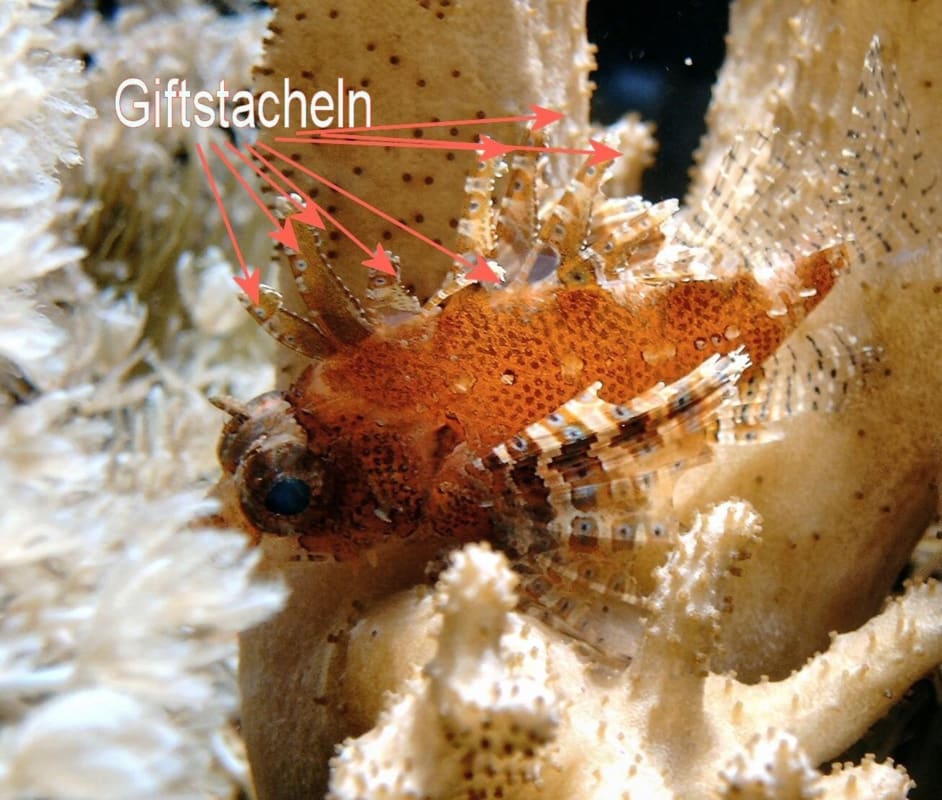
All lionfish, whether they are large species or dwarfs like the peacock-eye dwarf lionfish (12 cm), possess highly effective and dangerous venomous spines. The venomous spines in the dorsal, pelvic, and anal fins of the fish inject a protein compound into the victim (whether fish or caretaker) when stung, which – although usually not life-threatening – always causes prolonged, severe pain and various other reactions.
In the event of an injury with venom injection, immediate medical attention is required after an emergency/first aid treatment by immersing the wound in very hot water followed by the application of hot compresses, in order to initiate circulatory stabilizing measures. The risk of accidental injury to the caretaker by a lionfish in the reef aquarium is present with any “handling” in the tank and should not be underestimated!
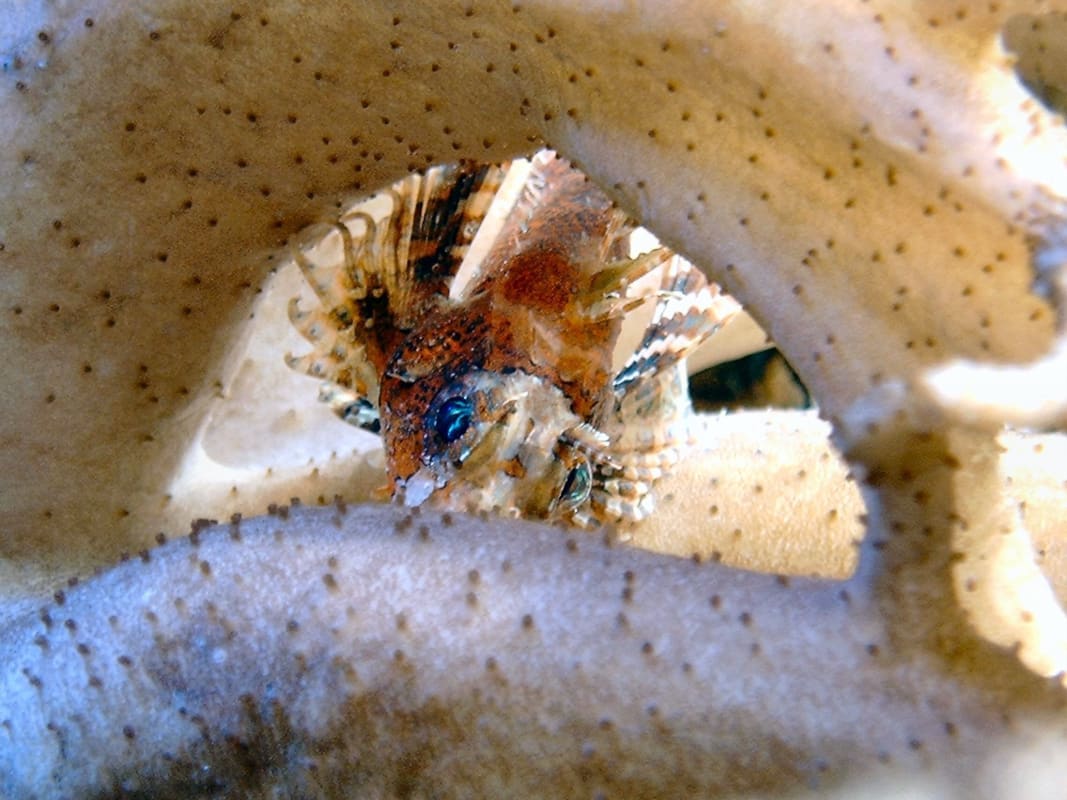
Lionfish are also true masters of camouflage. Resting on a coral branch or hiding in a reef crevice, waiting for prey, they can easily be overlooked by a caretaker whose attention is focused on another tank inhabitant, potentially resulting in accidental contact.
You should always wear protective gloves or, for larger cleaning tasks, consider separating the lionfish behind glass panes. In open aquariums, it’s crucial to prevent curious visitors or even children from reaching into the tank.
The practice
Taking into account the five criteria described so far
- fish size and swimming space,
- feeding requirements,
- reef structure and water flow conditions,
- predators,
- venom effects,
For stocking a reef aquarium with lionfish, I can highly recommend the zebra dwarf lionfish Dendrochirus zebra and the shortfin dwarf lionfish Dendrochirus brachypterus. Both species are usually easy to obtain through specialist retailers.
The zebra dwarf lionfish grows up to 13 cm in length and primarily feeds on various crustaceans such as shrimp, crabs, and amphipods. The shortfin dwarf lionfish is also among the relatively small lionfish species, rarely reaching its maximum length of 17 cm in the aquarium. It, too, primarily feeds on crabs and shrimp.
In my experience, both dwarf lionfish species never prey on other fish as long as they are fed regularly and sufficiently. “Sufficiently” means that their belly should always be slightly rounded, but not constantly bloated.
Attention: These two species are not particularly active swimmers and may sometimes become overweight as a result. One to two regular fasting days per week are beneficial and do not pose a risk to other tank inhabitants, as they will not be seen as a food source.
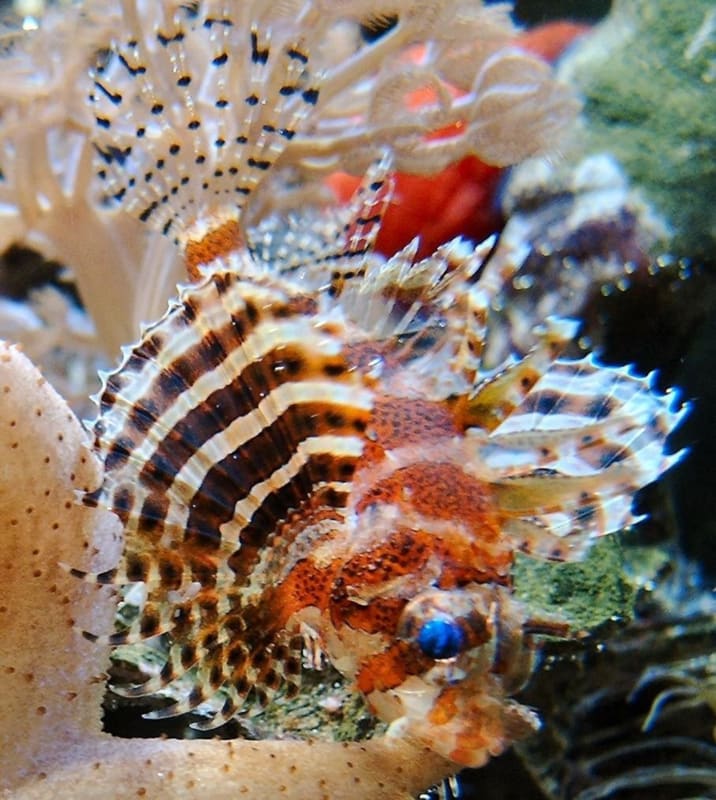
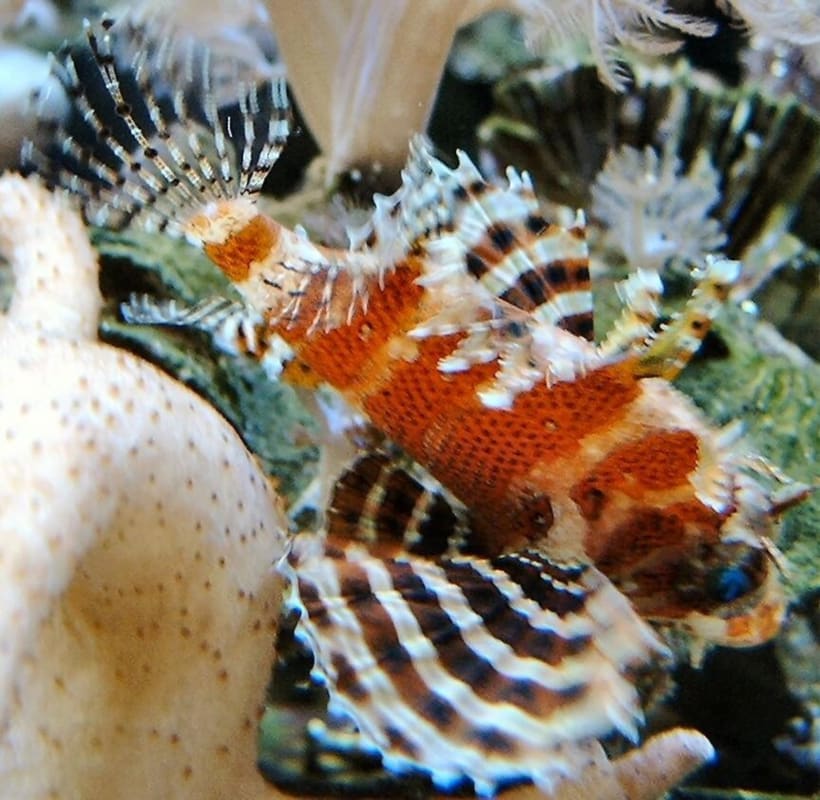
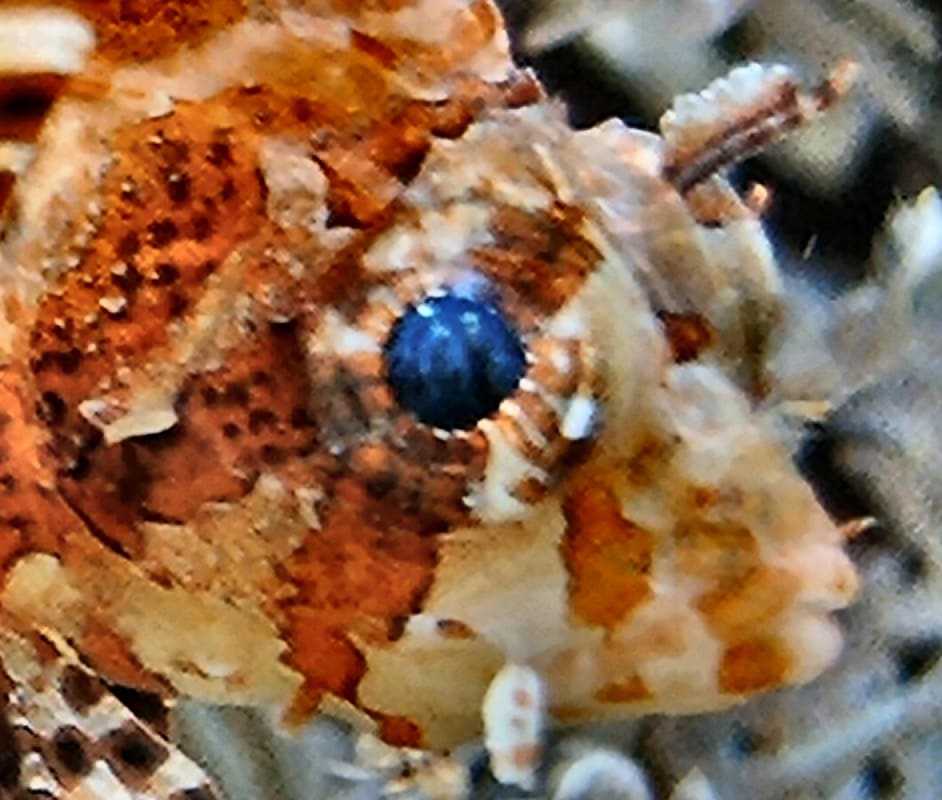
The dwarf lionfish of these species prefer to stay in slightly shaded, low-flow reef zones. They often rest with their heads slightly tilted down on reef overhangs, coral branches, or nestled within soft and leather corals.
Often, the only visible movement is the very alert eyes of the animals, while they patiently and tirelessly wait for passing prey for hours. In the aquarium, dwarf lionfish can easily be accustomed to frozen food. Krill, sand shrimp, and crab meat (occasionally enriched with vitamins) form a good base diet, which is occasionally supplemented with live mysis, shrimp, and adult brine shrimp.
The thawed and well-drained frozen food should not be too small, as, based on my observations, it is often rejected if it’s too tiny. Krill should be at least 1.5 cm in length. For live food, the size is of lesser importance; even the smallest jumping creatures consistently attract great interest. They are fixated on by the lionfish’s large eyes and ultimately captured with rapid speed. In this process, the hunters swim quickly from a distance and swallow the prey in an instant by opening their large mouths wide. The food is practically sucked in.
Like all lionfish, dwarf lionfish also possess very venomous dorsal spines. One should not be deceived by the size of the fish, especially with newly acquired juveniles that may only be 5 cm in body length, and mistakenly assume they pose less of a venomous risk. The venom can have the same effect as with an adult Pterois volitans! Therefore, always follow the mentioned protective measures, as young specimens of the dwarf lionfish are easily overlooked while working in the reef aquarium and could injure the caretaker, either actively or passively.
Occasionally, the dwarf lionfish undergo a multi-day “hunger strike.” Based on my observations, this typically occurs just before they shed their epidermis, or undergo ecdysis.
The epidermis is a single-layered epithelium that, like in all scale-covered fish, lies over the scales. In the epidermal epithelium, there are cells that produce mucus. This mucus helps facilitate smoother movement in the water and minimizes the growth of algae and sessile organisms. Lionfish “shed” their skin several times a year, sloughing off the epidermis in ragged pieces through sudden forward movements, a process that is occasionally assisted by rubbing against reef parts.
In my experience, lionfish are quite resistant to skin parasites and fungal diseases due to the described shedding process.
Dwarf lionfish are very resilient aquarium inhabitants that can live for many years as attractive residents in our tanks. They do not have high demands regarding water quality, but their feeding requirements do require the caretaker to take a targeted approach.
Compared to other fish, dwarf lionfish are generally compatible, but same-sex dwarf lionfish often fight. However, in my opinion, dwarf lionfish should not be kept individually, but rather in pairs. Since determining the sex of the fish can be quite difficult, I recommend observing the fish in the retailer’s display tank. This typically allows for the selection and purchase of two compatible animals.
Give it a try yourself: Especially in a reef aquarium, dwarf lionfish are a very attractive addition to the fish stock!
